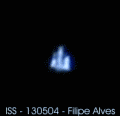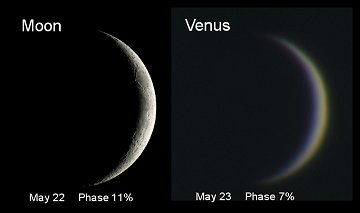 Would you like a call when the space station flies over your home town? Sign up for Spaceweather PHONE.
Would you like a call when the space station flies over your home town? Sign up for Spaceweather PHONE.
MARS & SATURN: Mars and Saturn are pleasingly close together in the western sky tonight. Look for the pair, only a few moon-widths apart, in the constellation Gemini after sunset. Saturn looks like a bright yellow star; Mars is dimmer and red, right beside Saturn. Point a small telescope at Saturn and you can easily see the planet's rings. [sky map]
Saturn is 1.4 billion km from Earth. Mars is closer, only 349 million km away. So why is Saturn brighter? Simple. Saturn, a gas giant with bright rings, is 18 times wider than little rocky Mars, so it reflects more sunlight.
SPACE STATION FLYBY: This week the International Space Station (ISS) is going to fly over many North American cities. Appearing just after sunset, it looks like an intense, slow-moving star. Only Venus is brighter! Visit one of these web sites to find out exactly when to look: Chris Peat's Heavens Above; Science@NASA's J-Pass. Or subscribe to SpaceWeather Phone and get a telephone call when the ISS is about to appear over your backyard.
 If you have a backyard telescope, try pointing it at the ISS when the space station glides overhead. You can see plenty of details: solar panels, trusses, living quarters and more. Filipe Alves of Lisbon, Portugal, recorded this movie on May 13th using a 10-inch telescope and a digital video camera. "The space station was difficult to track by hand," says Alves.
If you have a backyard telescope, try pointing it at the ISS when the space station glides overhead. You can see plenty of details: solar panels, trusses, living quarters and more. Filipe Alves of Lisbon, Portugal, recorded this movie on May 13th using a 10-inch telescope and a digital video camera. "The space station was difficult to track by hand," says Alves.
DISAPPEARING PLANET: Venus, remarkably bright and eye-catching, has been a fixture of the western sunset sky for months. But now it's about to vanish. It's sinking into the glare of the Sun as it heads for a historic solar transit on June 8th. Tonight may be your last chance to spot the disappearing planet. Don't wait! (continued below)

To the unaided eye, Venus seems improbably bright. It's even more amazing through a telescope. Venus looks like a slender crescent Moon. Witness these images (above) captured by Pete Lawrence of Selsey, West Sussex, UK.
 VENUS ECLIPSE: On May 21st, sky watchers across Europe saw a rare daytime eclipse of Venus by the crescent Moon. In Hungary, Zsolt Kereszty made this movie of Venus, a thin crescent, splitting in two then disappearing behind the Moon's dark limb.
VENUS ECLIPSE: On May 21st, sky watchers across Europe saw a rare daytime eclipse of Venus by the crescent Moon. In Hungary, Zsolt Kereszty made this movie of Venus, a thin crescent, splitting in two then disappearing behind the Moon's dark limb.
more images: from Douglas Cooper of Stirling, Scotland; from Wolf Manfred of Köngetried, Bavaria, Germany; from Jörgen Blom of Stockholm, Sweden; from Riccardo Di Nasso of Pisa, Italy; from Rijk-Jan Koppejan of Middelburg, The Netherlands; from Anthony Ayiomamitis of Athens, Greece; from Pete Lawrence of Selsey, West Sussex, UK; from Beom-Seok Yeom of Gyeonggi-do, South Korea; from Vladimi Ladinsky of Moscow, Russia; from Arne Danielsen of Oslo, Norway; from tianjixing.com of Beijing, China.

